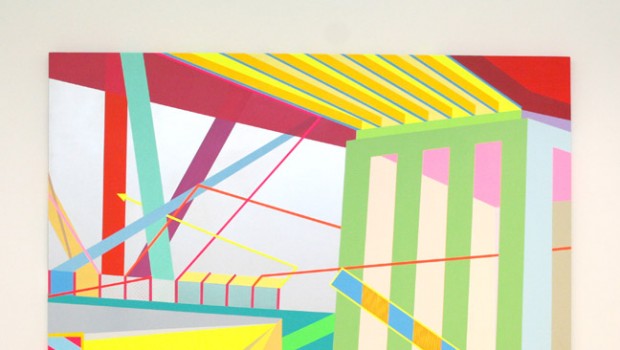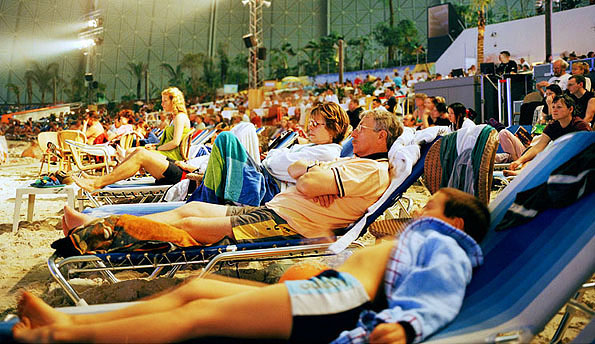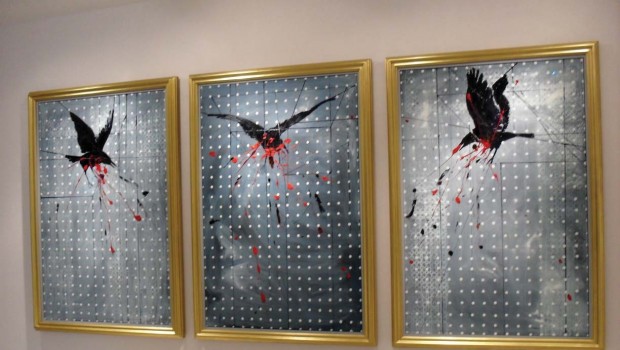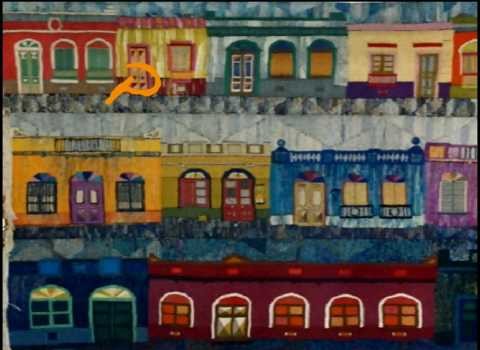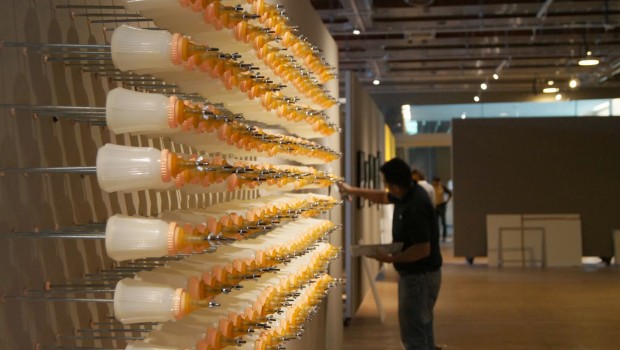Jonathan Leach, Abstract Painting in Context
John Zotos
Does the historical avant-garde persist as an inspiration to young artists today, and how exactly might it do so? Jonathan Leach, an artist who lives and works in Houston, paints abstract images on canvas and plexiglass objects as well as geometric abstractions informed by modernist and contemporary architecture and urbanism. His work seems to offer a somewhat commensurate view about aesthetics in comparison to art movements between the wars.
Specifically, the Bauhaus school in Germany and the Di Stijl movement in the Netherlands both advanced a fusion of fine arts with technique through a strong emphasis on abstraction. They hoped to bring the fruits of art into both design and architecture so as to make a difference in everyday life. The main difference between them being that Leach choses to remain in the realm of fine art and has no interest, up to now, in the functionalist program at the heart of either of these design schools.
In addition, his work illustrates a debt to the hard edge geometric abstract painting of Frank Stella in the late 50’s and 60’s with the stripe aesthetic and shaped canvases. Furthermore, a strong comparison can also be made to the work of Peter Halley by way of his day glo color palate, assymetrical diagonals, and the critique of architectural space.
In Recent Resonations, 2007, Leach remains within the verticality of the modernist canon in his format, but he counters with strong multicolored lines in the horizontal. He allows the planes to meet with one vertical gap in the middle of the composition, interlocking the two planes with a series of diagonals in the upper right. This leads to a comparison with Bauhaus artist Joseph Albers’ Upward, 1926, which, allowing for a completely different color arrangement, has similar tension with the vertical format of repetitive horizontal elements covering the picture plane. Albers uses a unifying vertical of color to break up the horizontal, as can be observed in Leach’s piece, and the work differs because he gives the complete image the notion of an abstraction from architecture
A source for the strong diagonals that Leach utilizes can be found in the work of the Di Stijl artist Theo Van Doesburg whose dogmatic tenor made him the philosophical mouthpiece for the movement. In contrast to Piet Mondrian’s theorization of neoplasticism as an abstract art of stasis and a rigid horizontal/vertical dichotomy, Van Doesburg offered his theory of elementarism that privileges dissonance, asymmetry, and most importantly the diagonal. This formulation led to the famous break with Mondrian and a new resource for Van Doesburg’s art. In Di Stijl magazine volume II, number 78 (1927) Van Doesburg writes:
In Simultaneous Counter Composition, 1929, Van Doesburg renders a perfect example of his aesthetics postulations about the diagonal in an abstract painting with four squares and two stripes. The squares retain the primary colors of neoplasticism being red, yellow, and blue, but here he adds a black square into the mix and tilts everything such that the composition has no center and the elements create a sense of motion and tension that counter the stasis and symmetry found in Di Stijl.
Leach uses diagonal stripes in order to reference contemporary culture and urbanism so his color palate shies away from primary colors in preference for a lighter range unthinkable in the 20’s. What comes through, though, is the debt to the avant-garde by way of animating the surface through endless intersections of stripes and planes of color. In
Broken Line, 2013, Leach sets up a complicated abstraction with gray, blue, green, red, and white elements. The lines intersect inside the plane, some flow beyond the surface as if hurling toward infinite space. Here, as in many of his works, the stripes describe three-dimensional spaces that confuse the viewer’s equilibrium as to what representations are at hand. In this piece the lines seem to indicate lines of force usually at work in physics as vectors that identify energy in specific directions. For Leach they perform several functions thematically by suggesting real space in the social landscape and also possibly a virtual space like the web. In this he leaves the Bauhaus and Di Stijl behind.
In the late 1950’s Frank Stella unveiled his first monochromatic stripe paintings. From these works followed countless examples by other artists inspired by the new possibilities of the medium, one pathway leading to minimalism. For Stella this new work was a reaction against the painterly expressionism of the New York School. By executing his pieces inductively according to a preconceived plan he debunks their dependence on spontaneity and expression, chance and subjectivity. Stella achieved this, and here we can see comparisons to Leach, not only by the formal design of the pieces such that the execution is an afterthought, but also through an insistence that an essential aspect of the works of art is their quality as objects themselves, rather than the two dimensionality that determined the reception of the New York School. The first of these stripe paintings, known as the black paintings, were executed on unprimed canvas with black industrial paint such that the pinstripes were the actual canvas as in Tomlinson Court Park, 1959.
In Object ‘F.T.’, 2012, recently included in an exhibition at Gallery Sonja Roesch in Houston, Leach takes his stripe aesthetic into the realm of sculpture in an engaging composition of two triangular pieces of Plexiglas on a base exhibited in a pedestal format. Violet, blue, orange and yellow stripes compete with the triangular geometry forming an object that is really a three dimensional painting reminiscent to themes in Stella’s work.
Leach’s stripe paintings grasp more than just the stripe revolution instigated by Stella, they are indebted also to Stella’s subsequent innovations involving shaped canvases, most famously in the protractor series, a perfect example being Hiraqla III, 1968. A large scale composition of roughly 300×600 cm, Hiraqla III was named after a middle eastern city and inspired by Islamic geometries in architecture and textile design. The shape of the painting includes two semicircular forms joined at the center resembling a reel-to-reel film shape or even eyeglasses. The fluorescent colors vibrate, creating motion that seeks to defy the two-dimensional.
By comparison, Leach’s painting Give it a Shot, 2011, includes several panels that form a shape that defies the standard rectangle/square formulation. His lines of black, pink, blue, and green traverse the surface from one panel to the next, unifying the surface with the assymetrical the vector energy directions mentioned above. Where Stella investigated pattern and sometimes symmetry, Leach retained the dissonance of Di Stijl while moving beyond his forebears into the contemporary world of the Internet and the science of non-verbal communication and icon signaling so prevalent in our world today.
A comparison to Peter Halley, by way of considering a prominent artist from the preceding generation, may clarify the turn to the post-modern and the presence of a hint of media and urban information transmission in Leach’s work. Looking at Broken Line, Recent Resonations, and Dark Device, 2011, the unwavering repetition of stripe elements in a cross hatch in long or short pulsations on the surface offer Leach’s signature style. This has a source in Peter Halley’s work from the 80’s in his cell and conduit series. In Blue Cell with Triple Conduit, 1986, three black parallel power stripe lines enter the surface from the left, turn upwards and pass through a blue square dead center, and exit through the top of the square turning right to exit the field. The formal similarities to Leach’s work are unmistakable.
Halley contends that conduits and the cells that they supply with energy and other resources play a part in the confinement, restriction, and administered aspects of human existence. This is pure postmodern theory straight from Foucault to Baudrillard. In The Deployment of the Geometric written by Halley in 1986, the same year he painted Blue Cell, he writes, “The regimentation of human movement, activity, and perception accompanies the geometric division of space” and “we can live in spectral suburbs or simulated cites.” The cells can represent dwelling spaces or virtual mental ones that humans occupy or visit in an unknown state of confinement. This was long before the Internet and the digitalization of today.
When Jonathan Leach paints his stripes and geometric spaces he references Halley’s imagery and day glo palate, perhaps thinking about video games and the internet; but also, he ruminates on the vicissitudes of the phenomenal experience of navigating real and virtual space and how the geometry guides participants through a rapidly changing social system. Leach leaves the postmodern indeterminacy behind, recuperating and reinventing geometry as a contemporary descriptive language for today’s world. Halley was responding to the rise of neo-expressionism in painting, a time when abstract art waned. Now the pendulum has turned round and Jonathan Leach puts geometries at work in his paintings for the specific purpose of describing and critiquing current realities surrounding urban space, perception, information flow, and the narratives that construct meaning.
Posted: March 9, 2014 at 2:13 am


